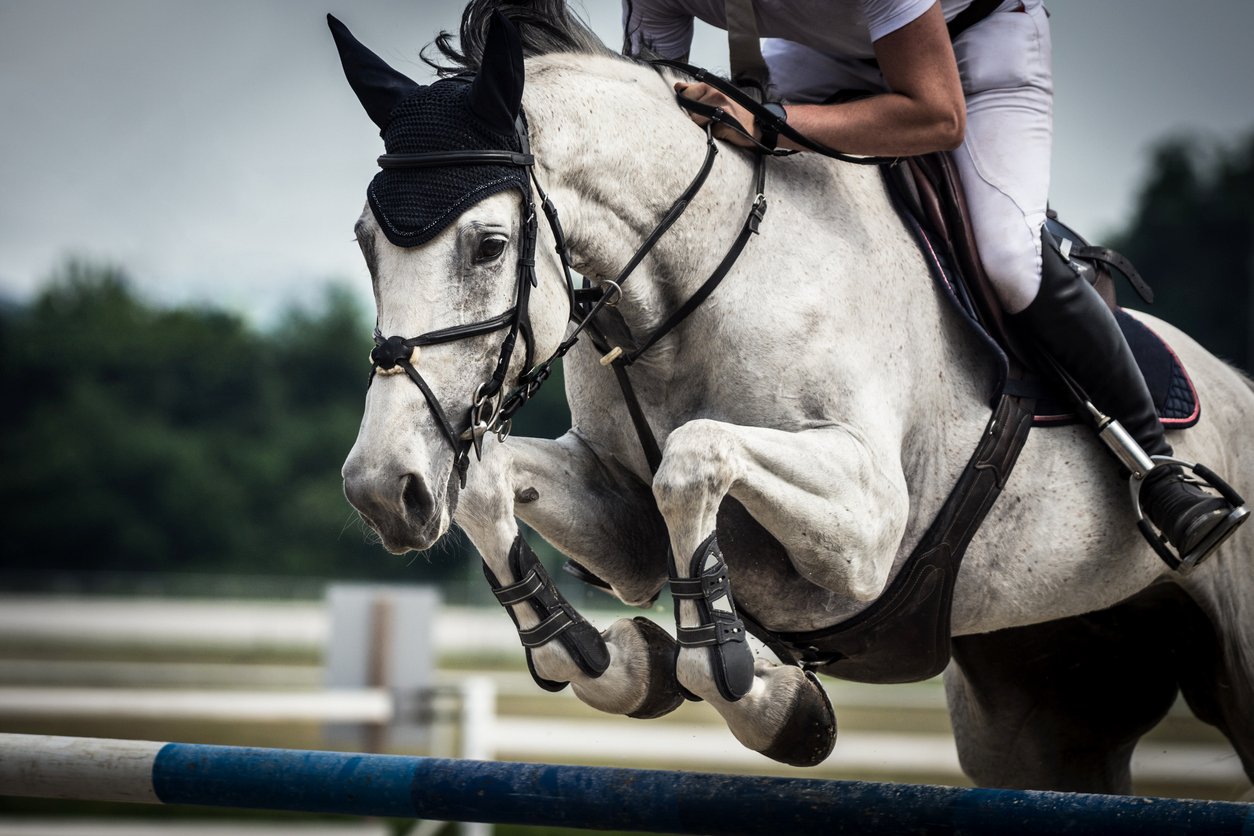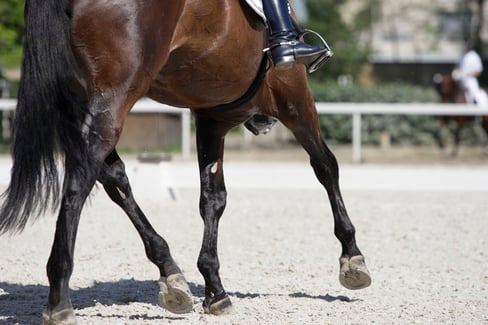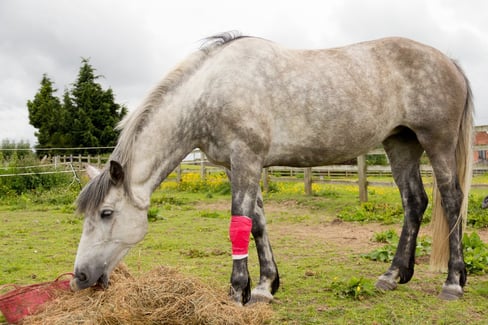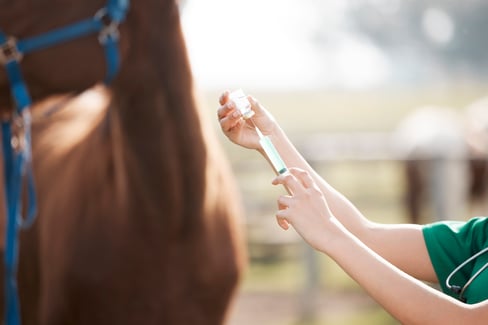Table of Contents
We love our horses just like we would any other pet or animal. So, when our horses start acting a little bit funny, we get worried. Especially when it comes to leg injuries.
Is your horse moving stiffly? Are they moving with any lameness? Do they seem reluctant to do their normal activities?
If that’s the case, your horse’s leg may be injured. And, if you can’t see any obvious soreness, swelling, or signs suggesting what the cause is, you may want to ask your vet about a stifle horse injury.
What is a stifle injury? Don’t worry, if you aren’t sure now, you will by the end of this blog post. In this post, we’ll go over what the stifle joint is, how injuries can occur, symptoms, treatment, and prevention tips.
Understand Stifle Joint Horse
The stifle joint is one of the largest and most complex in the horse, made up of two different joints – the femoropatellar joint and the femorotibial joint. It also connects four different bones
- The patella (kneecap)
- The femur
- The fibula
- The tibula
This joint is essentially the knee of a horse, although to see it you wouldn’t recognize it as a knee. It’s hidden in the meaty part of a horse’s hind legs. We’ve included a couple of diagrams of it below so you can see what we’re talking about.
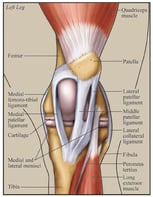
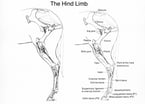
It will come as no surprise that this joint is important for your horse’s mobility, just like your knees are for you. The stifle joint of a horse, though, is not positioned in a directly upright position like a human knee is. Instead, it rests at an angle, as you can see in the image above. This angle, combined with the size and overuse of the joint, can make it prone to injury.
How Does Horse Stifle Injury Occur
Stifle joint horse injuries can happen in a variety of ways. They are more common in horses that do more high-intensity activities, like racing, jumping, or activities that involve a lot of stopping and starting, etc. This is because horses that are highly active are more likely to be injured, particularly in a delicate but large joint that could be potentially overused.
There are other ways this joint can be injured, as well. For instance, the underdevelopment of the muscles surrounding the joint can cause it to be injured. Horses can also be born with conditions that will cause issues to the joint over time. Three issues that can develop in a horse’s stifle have been outlined below.
Locking Stifle Horse
Your horse ‘locks’ their knees at night when they stand up to sleep. A locking stifle occurs when a horse’s patella (kneecap) becomes lodged in the upward, ‘locked’ position it takes on while sleeping. So, essentially, your horse’s leg is stuck in an extended position. There can be different severities to this locking. The leg may just need a bit of backward motion for the patella to slip back into place, or it could be more seriously stuck.
You can learn more about a locking stifle in horses in our blog post: Locking Stifle Horse – Definition, Diagnosis & Treatment.
Bone Cysts
Horses can develop cyst-like structures on their bones. When these bone cysts occur under the cartilage in the stifle joint, they can cause issues in your horse’s knee, like pain and swelling. According to Practical Horseman Magazine, these cysts can grow and cause erosion to the tissue and bone in time. Obviously, this can be an issue for your horse and its ability to move freely (as well as perform if your horse is used in sports and activities).
Arthritis
Any joint can develop arthritis over time, which is a condition in which the cartilage wears away, causing the bones to grind against each other when the joint is used. Obviously, this condition can be very painful, especially with the use of the joint, which can be an issue for overall horse health when such a large and important joint as the stifle is affected.
Diagnosing a Stifle Horse Injury
Your horse’s stifle can be injured in more typical ways, like becoming fractured, although that’s not common. Because this is a large joint that bears a lot of weight and pressure, it can be prone to getting injured. Luckily, though, according to a 2022 Equus Magazine, a stifle horse injury is easier now to explore and diagnose due to advancements in medical imaging.
If you suspect your horse is suffering from a leg injury (or a stifle injury specifically), you can book an appointment with your vet. Your vet will perform a physical examination of your horse, including potentially feeling around the horse’s stifle, to see if they can feel any issues. However, they’ll also be able to use medical imaging so that they can actually see any injury your horse has to the stifle. From there, the injury can be identified, as well as any other damage that either caused the stifle injury or was caused by the stifle injury.
To have your horse diagnosed with a stifle horse injury, though, you’ll first have to notice that something is wrong. So, what are horse stifle injury symptoms? How can you recognize them so you know when to call your vet to take a look?
Horse Stifle Injury Symptoms
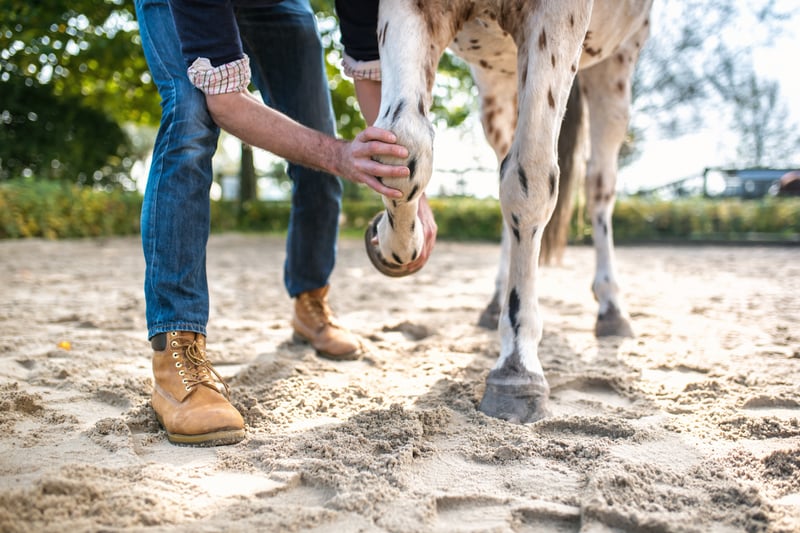
It can be difficult to pinpoint symptoms specifically related to a stifle horse injury. Instead, you’ll probably notice symptoms that your horse’s leg is bothering them. Once you call your vet, they’ll be able to identify where the problem is, as there are many places along a horse’s leg that can be prone to injury, like a bowed tendon horse, for instance.
That being said, there are still symptoms you can look out for, some of which are included in the table before.
|
Symptom |
Description |
|
Lameness |
If your horse has any change to its gait, this counts as lameness. Typically, lameness is a symptom of some form of leg injury or condition. Lameness can range in severity, but if your horse is showing any signs of lameness, you may want to consider calling your vet, especially if it’s been for a prolonged time. |
|
Leg Tenderness |
If your horse’s leg is tender to the touch, particularly in the area around the stifle, they may have a horse stifle injury. You may want to look for other symptoms, like swelling or irritation, but make sure you take your horse to the vet for a diagnosis of the issue. |
|
Reluctance to Move |
If your horse is showing reluctance to move, shown as either a slowness and hesitation to get going or a pause in their gait, that can be a symptom that something is amiss with your horse’s leg, particularly with the stifle. |
Stifle Injury Horse Treatment Options
While each horse has unique needs and your vet can provide more specific recovery plans for your stifle horse injury, there are generally different treatment options for a stifle horse injury:
- Horse joint supplements
- Horse joint injections
- Physical therapy
- Surgery
- Lifestyle changes
These treatments have been elaborated on in the table below. The treatment that your horse receives will depend on a few different factors, some of which include:
- What the horse stifle injury is
- How severe the injury is
- The lifestyle of your horse (if more than one treatment option can be used)
|
Treatment Option |
Description |
|
Horse Joint Supplements |
Horse joint supplements can be fed to your equine dealing with a stifle horse injury in order to reduce pain and inflammation, and help repair cartilage that is damaged. It’s also great for helping horses develop strong, healthy joints and soft tissues, so they are better equipped to face a stifle horse injury in the future. |
|
Horse Joint Injections |
Horses can be given pain-relieving medications in different ways, including horse joint injections. These injections can come with risks, especially with long-term use over time or overuse, but they can still be a good treatment option for certain stifle horse injuries. You’ll need to discuss with your vet if they’re the right treatment option for your horse and how best to go about it (including a schedule, dosage, and recovery). |
|
Physical Therapy |
Horses can go through physical therapy to help with their mobility and healing in light of an injury, just like humans. Although you may be able to do some of the exercises with your horse yourself, we recommend you use a professional, at least at first. |
|
Surgery |
Depending on what the stifle horse injury is and how severe it is, your horse may need to undergo surgery to fix it. After your horse is finished with their surgery, you’ll need to allow them to rest, following a plan laid out by your vet for when they’re able to complete the exercise again and how much. Likely it will be a gradual process getting your horse back to where they used to, and a joint supplement with hyaluronic acid can help to get them there more quickly by reducing pain and inflammtion post-operatively. |
|
Lifestyle Changes |
Depending on the stifle horse injury your horse has, you may need to make some lifestyle changes for them. For instance, maybe they will need to retire from competing, or maybe they just need a change to their diet, maybe their exercise schedule will need to change, etc. This treatment option likely won’t be good enough on its own but instead may combine with others. |
Your horse can likely receive treatment for a stifle horse injury they have. However, whether or not they’ll be performing at their peak ever again depends on the injury and the treatment process. What counts, though, is that a stifle horse injury is not the end of the world and in all likelihood, your horse will be fine.
That being said, life would still be easier if your horse avoided getting any sort of stifle injury in general. And, lucky for you, we’ve outlined some tips below on what you can do to help prevent your horse from suffering from a stifle horse injury.
Stifle Ligament Injury Horse Prevention Tips
We’ve discussed symptoms and treatments available if your horse does get a stifle injury. But, what can you do to prevent your horse from getting a stifle joint injury in the first place? We’ve included four steps below. However, note that these are things you’ll want to do for your horse anyway, as they are a part of providing your horse with a healthy lifestyle in general.
But, allow us to explain how they pertain to stifle horse injury prevention in particular.
Don’t Overwork Your Horse
Horses that are involved in physically demanding sports and activities are more likely to develop stifle injuries. This doesn’t mean you shouldn’t involve your horses in these activities. It doesn’t mean it’s inherently bad to barrel race your horse. Especially because poor musculature can also lead to a stifle horse injury.
Instead, it just means you need to be careful about not overworking your horse. If your horse is showing signs of being in distress or pain while they’re being exercised, then allow them to be done. When your horse is finished being exercised, whether it came to a natural close or needed to be ended early, make sure they have lots of time to rest and recuperate (and maybe a vet is called if necessary).
Life is about balance, and that should be no different for your horse. So, just make sure you’re balancing vigorous exercise with lots of rest for your horse. That way, your horse will be healthy and strong but less likely to become injured, including their stifle.
Feed Your Horse a Proper Diet
You’ll want to keep your horse strong, especially if they’re living a physically demanding lifestyle, by feeding them a proper, healthy diet. To do that, you need to do two things.
Make sure your horse is eating enough. A 1000 lb horse needs between 15,000 and 33,000 calories depending on how active your horse has been. That’s a lot of food. You need to ensure you’re doing what you can to ensure your horse is eating the calories they need (not more or less).
Make sure their equine nutrition is balanced. You want to ensure your horse is eating a healthy diet. Obviously, horses graze and will eat grass and hay. But make sure you’re adding other healthy foods for your horse, as well. You may need to do some research to find out what the best diet for your horse would be. A vet will also be able to provide you with some recommendations.
Just like in people, if you make sure your horse is eating a healthy diet where they’re getting all the calories, nutrients, and vitamins they need, your horse will be much healthier and stronger. And a healthy, strong horse is less prone to injury, including with their stifle. This can be especially important for making sure your horse’s musculature isn’t underdeveloped because this can lead to stifle issues.
However, you also need to make sure your horse isn’t overweight. Extra pounds on your horse will be putting extra pressure on their stifle joints, which may make them more likely to become injured. A healthy diet of the proper number of calories should help keep your horse’s weight in check, too.
Add Supplements to Your Horse’s Diet
You can bolster your horse’s diet even more with supplements. Different supplements will target different areas. Just like with your horse’s diet, you’ll have to find the right supplement for your horse. For instance, you may be interested in supplements that target muscle health to ensure the muscles around the stifle joint stay well-developed, or you want to try joint supplements which can help strengthen your horse’s stifle joints.
Two great examples of joint supplements are our TRI-ACTA and TRI-ACTA H.A. for Equine. These supplements include a variety of great ingredients without all the filler. In fact, TRI-ACTA has only three ingredients, and TRI-ACTA H.A. only four.
Those ingredients are:
- Glucosamine: repairs cartilage
- MSM: reduces pain and inflammation
- Chondroitin: helps prevent the destruction of cartilage
- Hyaluronic acid: lubricates joints (this ingredient is the fourth in TRI-ACTA H.A. and not in the other.)
With supplements like these, you’ll be able to keep your horse’s joints well-maintained. To learn more about supplements for your horse, check out our post on Horse Supplements.
TRI-ACTA H.A. for Equine
Our maximum strength formula is perfect for horses that are ageing, experiencing arthritis and stiffness, are in training and competition, or under a heavy workload.
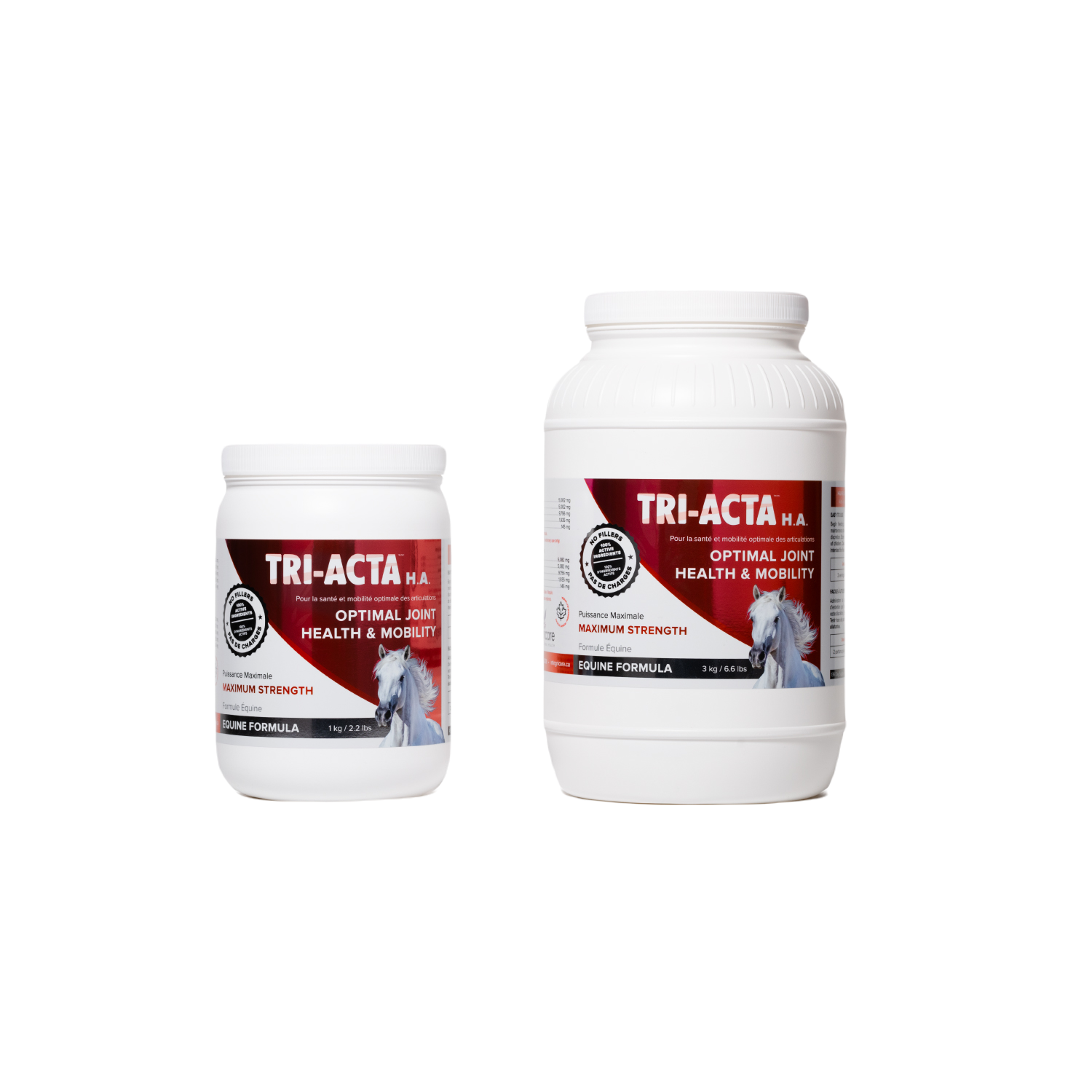
Take Care of Your Horse’s Health
By this, we mean have regular vet, physical therapy, and massage appointments for your horse as necessary. This sort of regular attention can be especially important if your horse is involved in sports like racing, jumping, etc. or if your horse has been injured in the past.
With these sorts of regular appointments, if your horse does develop an injury, it will be captured quickly and looked after in a timely manner. The people involved in these appointments will be like a support team for your horse to help keep them healthy, just like you.
So, although this step won’t necessarily prevent a stifle horse injury in and of itself, it will allow your horse’s health to be monitored to ensure your horse’s health and strength in general, and any issues to be found and treated quickly.
However, physical therapy and massage can also be preventative for future issues.
FAQ for a Stifle Horse Injury
Can a horse recover from a stifle injury?
Yes, a horse can recover from a stifle injury! Due to the evolution of medical imaging, veterinarians are now able to see issues in the stifle without surgery and therefore diagnose problems and treat them more easily.
Treatment options for your horse include things like:
- Joint injections
- Horse joint supplements
- Physical Therapy
- Surgery
- Lifestyle Changes
Of course, the prognosis still depends on how injured your horse is, and what the injury is. But, even if your horse is never performing at its peak again, your horse will likely be fine.
What is a stifle injury in a horse?
A stifle injury in a horse is any injury that affects the stifle joint. It can range in cause, issue, and severity. Some examples of conditions that can affect the stifle joint include
- A locking stifle
- Bone cysts
- Arthritis
However, the stifle can be injured in other ways, as well (including ways that may be considered more traditional as injuries).
Symptoms that your horse has an injury to their stifle can be difficult to differentiate from any other leg injury. For example, your horse may experience lameness, but lameness is a common symptom of a variety of leg injuries. Therefore, if you suspect your horse has an injury, it's best to book an appointment with your vet so they can diagnose the issue.
Can you ride a horse with a stifle horse injury?
Whether you can ride a horse with a stifle injury may depend on the injury, severity, and treatment your horse is undergoing for it. However, you should not let an injured horse be ridden without your vet’s go-ahead. We would also recommend not letting a horse that has not yet been diagnosed but is showing signs of injury be ridden, either.
If you’re unsure about whether your horse is okay for being ridden or not, but you know they have an injury of some sort, it’s best to leave them rider-free, at least until you’ve consulted a vet and received their determination. You wouldn’t want to exacerbate the injury, both by adding weight and strain to it and by having your horse overuse the injured limb.
In Summary

The stifle of your horse is essentially its knee, so any horse stifle injury they may get can be debilitating for your horse. They may show symptoms such as
- Lameness
- Leg tenderness
- Reluctance to move
Luckily, advancements in medical imaging mean that your horse can get a diagnosis of the issue easier than would have happened in the past, and a treatment plan can be created. Treatment options include things like
- Joint injections
- Horse joint supplements
- Physical therapy
- Surgery
- Lifestyle changes
The treatment that’s right for your horse will depend on the stifle horse injury your horse has. Not every injury requires surgery.
That being said, it’s still best to avoid stifle injuries in general, if possible. So, some tips to help prevent a horse stifle injury include
- Not overworking your horse
- Feeding them a healthy diet
- Giving them supplements
- And looking after their medical health
To get started on those tips, you can shop our equine supplements here.
TRI-ACTA for Equine
Providing preventative support for younger horses and helping mitigate the early onset of joint degeneration and other mobility issues.
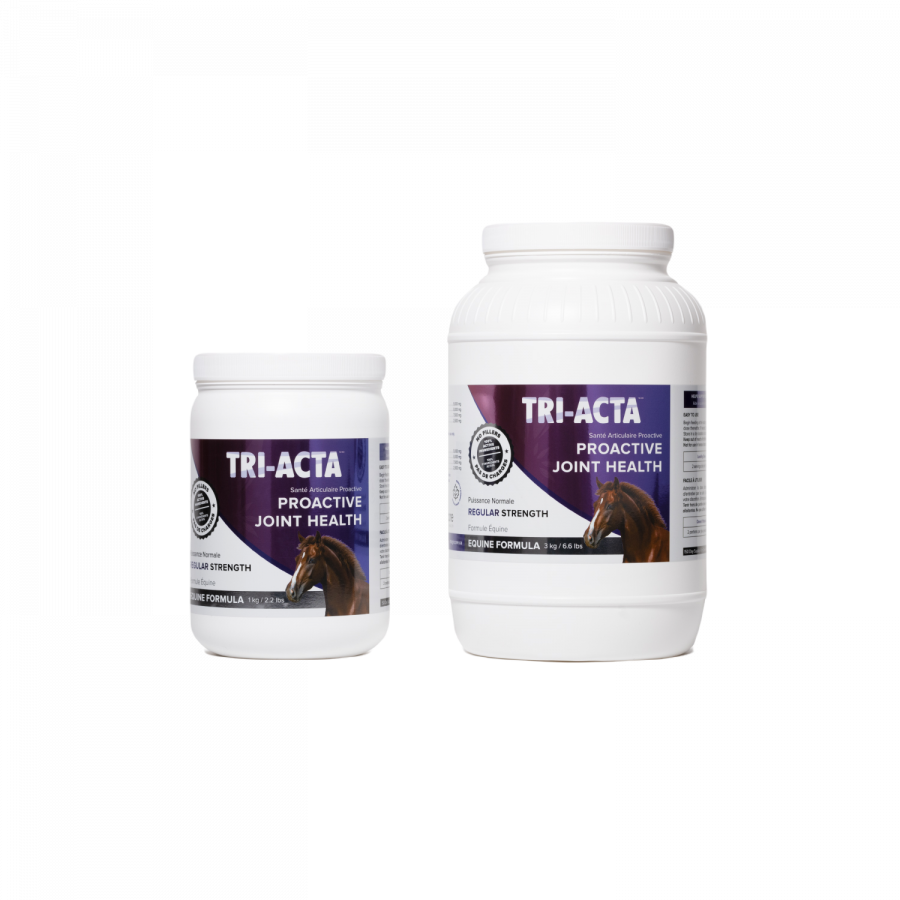
To learn more about your horse’s health, you can read our blog or check out our resources page.
And, if you have any other questions, don’t hesitate to contact us.
Newsletter Signup
Subscribe to our newsletter to receive the latest news and exclusive offers.
.jpg?height=2000&name=Cliick_Integricare-DISPLAY-REVISEDV2%20(1).jpg)
Proactive & Therapeutic Joint Supplements
When given daily, Integricare joint supplements recover bone and joint injuries faster and help prevent mobility injuries from happening in the first place.

